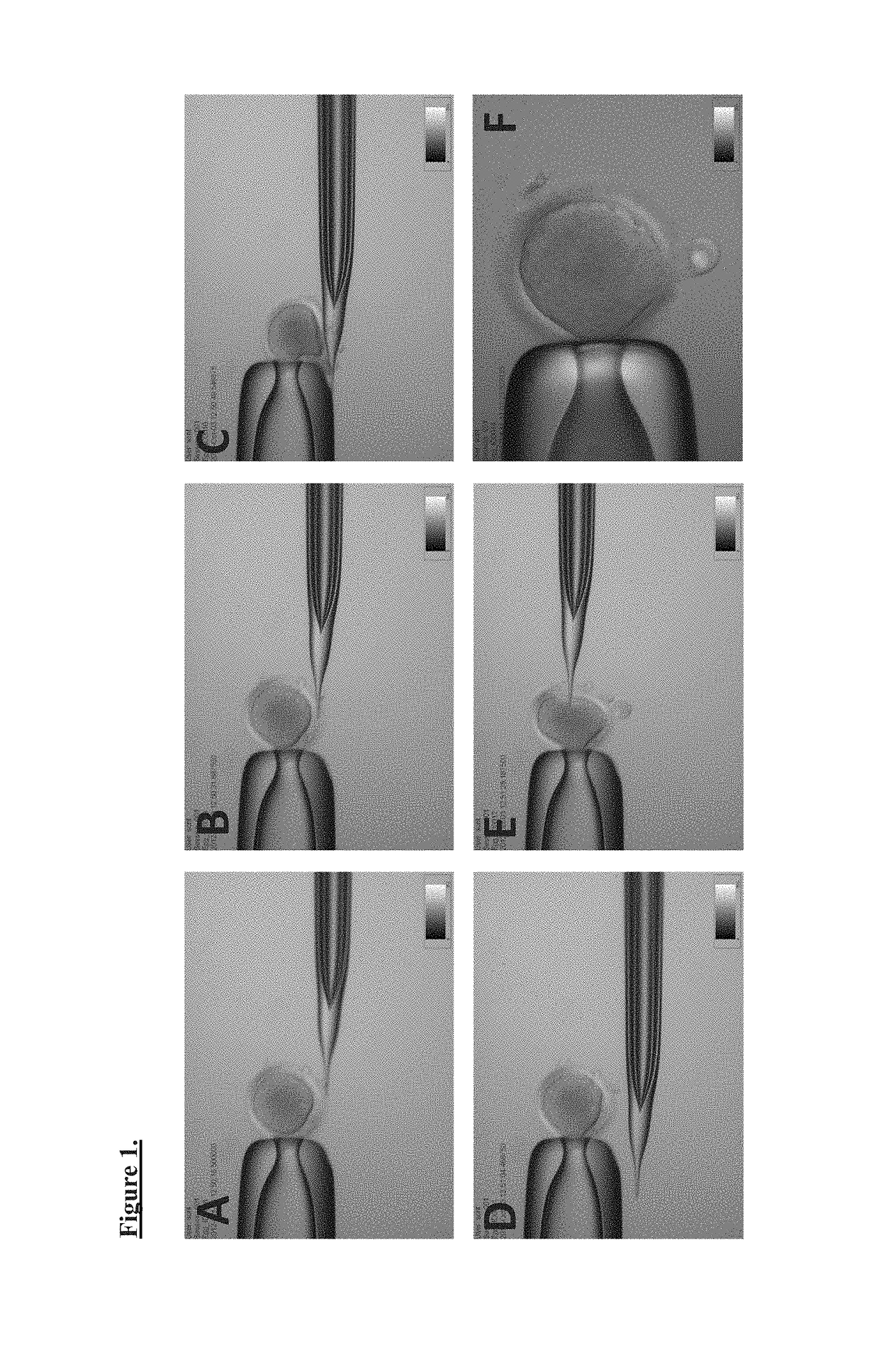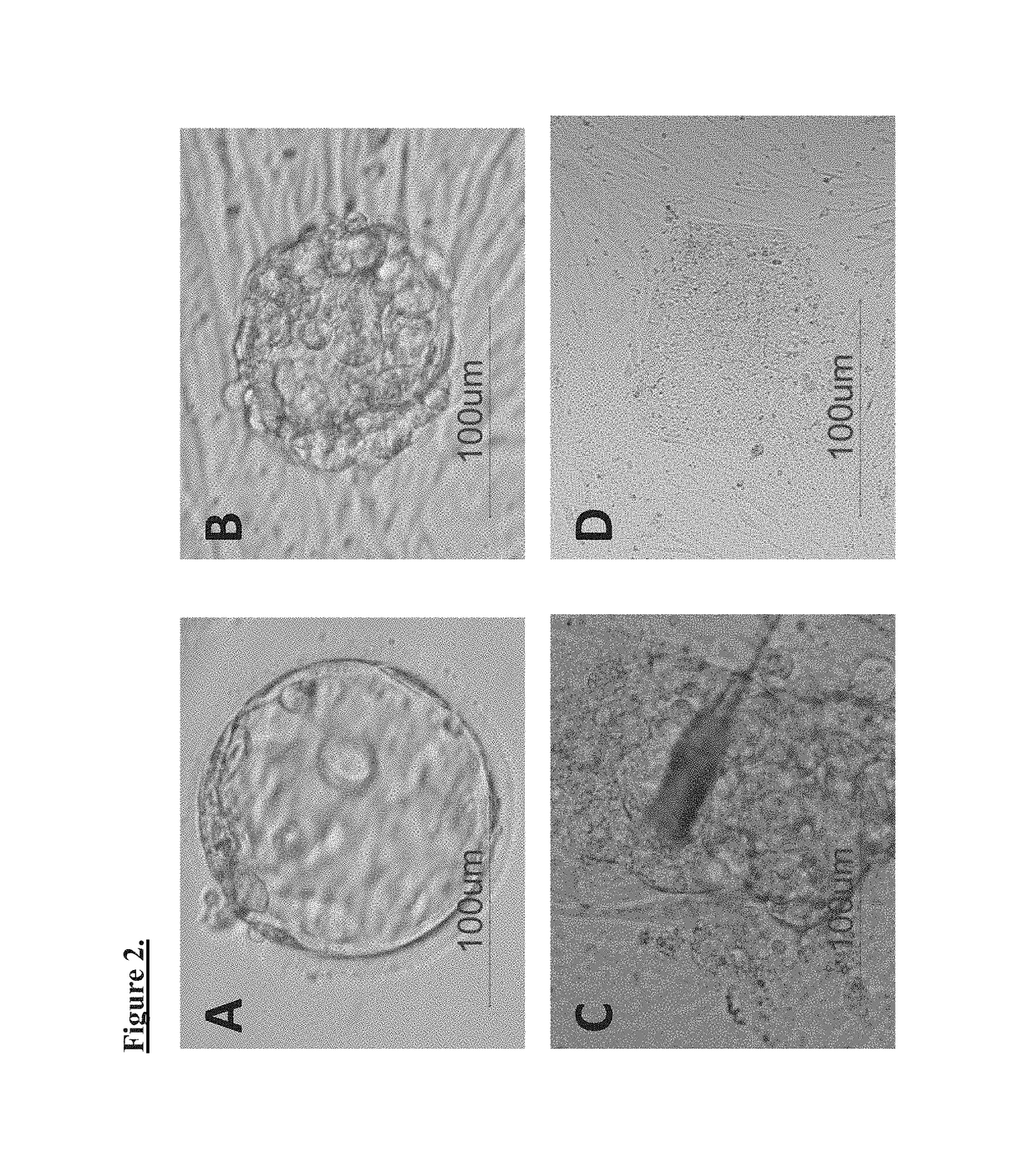Production of parthenogenetic stem cells and patient-specific human embryonic stem cells using somatic cell nuclear transfer
a technology of human embryonic stem cells and somatic cell nuclear transfer, which is applied in the field of immunocompatibility pluripotent stem cells (pscs), can solve the problems of preventing practical clinical application, overlapping significant technical procedures related to both techniques, and near limitless resources of transplantable materials
- Summary
- Abstract
- Description
- Claims
- Application Information
AI Technical Summary
Benefits of technology
Problems solved by technology
Method used
Image
Examples
example 1
General Procedures Related to Parthenogenesis
[0064]The critical procedures for parthenogenesis involve 1) preparation of human MII stage oocytes 2) activation of oocytes 3) generation of parthenotes 4) further in vitro culturing up to blastocyst stage and 5) derivation of human pluripotent stem cells (hPSC) from cultured blastocysts. Cells derived via this process are parthenote-derived human pluripotent stem cells (pn-hPSCs).
example 2
General Procedures Related to SCNT
[0065]Somatic cell nuclear transfer (SCNT) involves overlapping techniques with parthenogenesis, although the key differences involve the transfer of donor nucleus to recipient oocyte and embryo reconstruction. More specifically, SCNT includes 1) preparation of nuclear donor cells, 2) preparation of human MII stage oocytes, 3) enucleation of oocytes, 4) somatic cell nuclear transfer to the enucleated oocytes, 5) activation of the somatic cell nuclear transferred (reconstructed) eggs, 6) culture of the reconstructed eggs in vitro up to blastocyst stage, and 7) derivation of embryonic stem cell lines from those embryos. Cells derived via this process are somatic cell nuclear transfer human pluripotent stem cells (NT-hPSCs).
example 3
Preparation of Nuclear Donor Cell Lines Using Adult Fibroblast Cells
[0066]Donor patients' fibroblasts can be grown from skin biopsies with individual cells retrieved from the monolayer by trypsinization, or similar process. Nuclei can then be obtained from adult fibroblast cells, using the following example protocol.[0067]1. Obtain skin or other tissue biopsy under local anesthesia (50 mg, 0.5×0.5 cm).[0068]2. Wash tissue fragment twice in PBS.[0069]3. Mechanically mince tissue with a surgical blade on a 100-mm culture dish and carefully remove PBS from minced tissue.[0070]4. Re-suspend tissue pellet in a 4.5 ml DMEM supplemented with 10% FBS, 1% non-essential amino acids and 10 ug / ml penicillin-streptomycin solution, and 500 ul (2000 unit / ml) of collagenase type II (Life Technologies).[0071]5. Place into incubator overnight.[0072]6. Centrifuge at 300×G for 3 min, and re-suspend cell pellet in DMEM with 10% FBS.[0073]7. Seed cells into a 60-mm culture dish and subsequently culture u...
PUM
| Property | Measurement | Unit |
|---|---|---|
| diameter | aaaaa | aaaaa |
| concentration | aaaaa | aaaaa |
| concentration | aaaaa | aaaaa |
Abstract
Description
Claims
Application Information
 Login to View More
Login to View More - R&D
- Intellectual Property
- Life Sciences
- Materials
- Tech Scout
- Unparalleled Data Quality
- Higher Quality Content
- 60% Fewer Hallucinations
Browse by: Latest US Patents, China's latest patents, Technical Efficacy Thesaurus, Application Domain, Technology Topic, Popular Technical Reports.
© 2025 PatSnap. All rights reserved.Legal|Privacy policy|Modern Slavery Act Transparency Statement|Sitemap|About US| Contact US: help@patsnap.com


